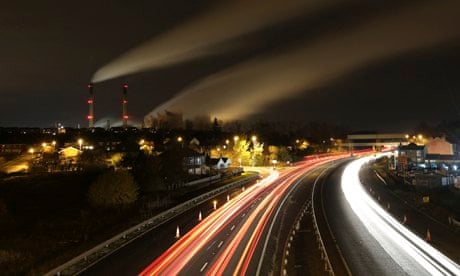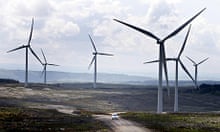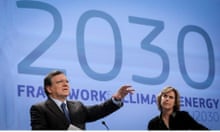On climate change, Britain is leading in Europe. Wednesday's proposal by the European commission for a binding 40% greenhouse gas reduction target by 2030 is a significant step forward. The commission has accepted our core argument that the EU's domestic emissions reduction target must be ambitious so we can influence countries like the US and China, ahead of 2015's critical global climate talks.
By leading on a strong emissions reduction target, the UK is persuading others on the need for member states to have the freedom and flexibility to develop their own energy mix to achieve these ambitious reductions. Rigid technology specific targets set for each country would not be cost effective – and EU members should be free to decarbonise in a way that is right for them, including renewables, nuclear, carbon capture and storage and energy efficiency.
Energy policy's central conundrum today is how to go green at the lowest possible cost. The commission's analysis confirms that British households pay some of the lowest prices for gas and electricity in Europe, but that is little comfort to people struggling to pay rising energy bills. So we have to achieve a fine balance. We need to invest in home-grown clean energy that will bring cheaper prices in the long run, shielding consumers from volatile international fossil fuel markets. But we also need to take people with us as we transition to a low carbon economy, and that means keeping the costs of going green as low as possible.
Pricing carbon in carbon markets is undoubtedly part of the answer. That's why the UK has backed major reform of Europe's emissions trading system. So the commission's proposed restructuring of the EU ETS is another step forward. While not the comprehensive reform we want, improving emissions trading in Europe is crucial and urgent given the impressive advances on carbon markets being made in countries like China and Korea.
However, the early experience of carbon markets suggests it would be unwise to rely on them alone. Europe's low carbon price was behind the Chancellor's initiative to bring in Britain's carbon price floor. It also influenced our reforms of Britain's electricity market designed to offset the primacy of fossil fuel generation.
With the Energy Act 2013, the coalition has a British solution to low cost green energy – the creation of the world's first low carbon electricity market. Our answer to the challenge of going green cost effectively is technology neutrality, driven by both competition and early support for less mature low carbon technologies like carbon capture and storage and offshore wind. Just like Britain's world first power sector decarbonisation target – backed by most of business and all the green NGOs and which I legislated to set in 2016 – this technology neutral approach creates the stability and certainty for climate-friendly energy investment.
And green investment is flowing into Britain. In just three years since 2010, there has been almost £40bn of investment into the electricity sector, most of this into renewables. Bloomberg has measured average annual investment in renewables to be almost twice as high in this parliament compared to the last. The government has seen renewable electricity generation more than double since 2010. .
Britain's green boom will accelerate. This spring, I expect to sign the first contracts under our new Energy Act regime for a host of new renewables projects. The financial and legal stability we've provided means investors are queuing up to get our contracts. Yet because we're protecting consumers and business with a constrained budget for this investment, we won't back every project: firms complaining because their project missed out will be a sign of cost effective success.
But Britain cannot go it alone. UK emissions make up less than 1.5% of the global total. That's why the EU's 2030 agenda is so vital. By acting through the EU, we minimise any short term costs, and maximise green growth. And a climate ambitious EU is better placed to convince large carbon emitting economies of the world to join us to beat climate change.
The commission's proposals are just the start. We will work hard with our partners for a final deal that is good for UK consumers, our economy, and the climate. But it is encouraging that the coalition's efforts to lead in Europe on climate change are bearing fruit. Last year I set up a Green Growth Group with likeminded EU ministers to co-ordinate efforts for an ambitious outcome. This helped keep reform of the EU's flagging carbon market on track and focussed minds on producing a 2030 framework that has flexibility and cost-effectiveness at its core.
For the UK, achieving an ambitious EU emissions reduction target remains our key objective. It is the only target that matters for tackling climate change. It's the measure used in global climate change talks and it links directly to our own carbon budgets system and a future UK 2030 decarbonisation target. And Britain has been clear: a Europe-wide target of 40% is the least we should aim for. We will continue to push for a 50% European target, if there is an ambitious global deal on climate in 2015.
The commission has also proposed setting a new 2030 renewable energy target for the EU as a whole. This is very different from the 2020 renewables target – which was binding on each member state, and if repeated for 2030 would have contravened Britain's neutral green technology approach to decarbonisation.
The 2020 renewables target made sense when it was set: it has helped the early investment needed for immature renewable technologies and played a part in driving down the costs of key technologies like solar PV and onshore wind. Yet to repeat this for the 2020s doesn't make sense. Some renewable technologies are already nearing grid parity, and we need to see investment in other immature low carbon technologies like carbon capture and storage. Our analysis shows that an ambitious emission reduction target will still stimulate massive investment in renewables across the EU, but without all the inflexibility, costs and risks of a technology specific target.
Britain needs a diverse energy mix - home grown renewables, new nuclear, a switch from dirty coal to cleaner gas, and, when the technology is ready, carbon capture and storage. Diversity will keep the lights on and ensure we go green at the lowest possible cost. Likewise for Europe. Low carbon technology diversity will help the EU lead the world – both at the 2015 global climate change talks and in winning the global race for green growth.






